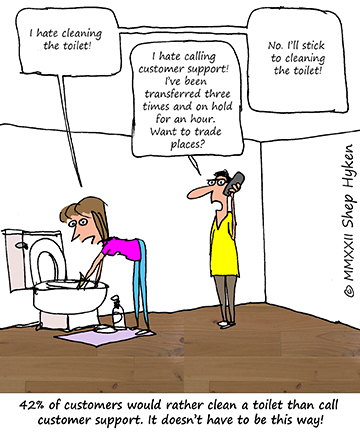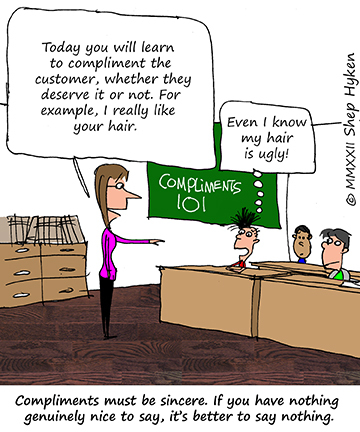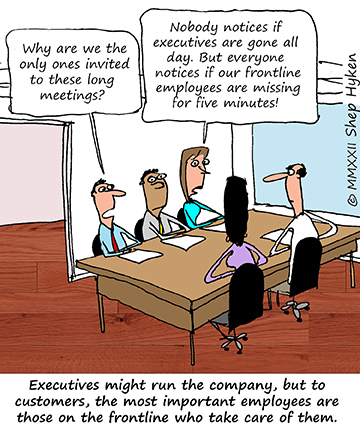Shep Hyken's Blog, page 64
May 16, 2022
5 Top Customer Service Articles of the Week 5-16-2022
Each week I read many customer service and customer experience articles from various resources. Here are my top five picks from last week. I have added my comment about each article and would like to hear what you think too.
Are You Tracking the Customer Service Metrics That Really Count? by Jonathan Byrnes and John Wass(Harvard Business Review) The biggest customer service problem for many managers is that they focus almost exclusively on day-to-day tactical customer service issues and fail to develop the latent, strategic customer service opportunities that would lock in and grow their most important customers.
My Comment: We kick off this week’s Top Five roundup with an excellent article about the best customer service metrics. Yes, metrics matter. Peter Drucker is often quoted as saying, “You can’t manage what you can’t measure. In addition to the traditional metrics, my take is that you should also measure customer behavior. Does the customer come back? How often? How much do they spend when they do? Typical metrics are history lessons that are valuable. Measuring behavior gives us real-time information.
How to Measure CX Impact by Jim Tincher(CustomerThink) We CX folks love to discuss measurement. If you want to fill a room at a conference, just put the word “metric” in your session title, and you’re good to go. Mention “Net Promoter Score” or “Customer Effort Score,” and you’ll need to order more chairs. That’s because we spend so many of our waking hours – and for some, sleepless nights – trying to figure out how to measure CX impact.
My Comment: While on the theme of measurement, here’s an article by CX thought leader, Jim Tincher. He believes in NPS, CSAT, and others, as long as they are used correctly. He also believes it’s important to measure the touchpoints found in a customer journey map. There’s quite a bit packed into this short article.
Here’s How To Maintain Customer Service, Even When You’re Short-Staffed by Forbes Business Council(Forbes) 14 members of Forbes Business Council shared how managers can ensure high-quality customer service with a lean workforce. They offered some key insights on how to keep a short-staffed team’s morale and a business’s reputation afloat, despite the challenges being faced.
My Comment: The labor shortage is taking its toll on many businesses. Customers are complaining that service is worse than ever. The ACSI (American Customer Satisfaction Index) is at a low. Many companies are struggling to deliver customer service with fewer employees. Perhaps this article, with 14 ideas from the Forbes Expert Panel, can give you an idea or two you can use.
How to Calculate: Customer Lifetime Value Formula (CLV) by ClientSuccess(ClientSucces) When a new customer joins your book of business, there are some things that are known right out of the gate. The ‘sale’ of a new customer – aka the monetary amount of the contract – is often looked at as the be-all-end-all metric to determine the value of the customer. This number is also used to determine ARR (annual recurring revenue), which shows how much revenue will come in each year from this initial contract.
My Comment: I’ve shared articles on this topic in the past, yet I’m still asked the question, “How do you measure customer lifetime value (CLV)?” It’s important to know the number, as it helps guide important decisions. Here’s a short article that includes a formula and some additional information.
Be a ‘Method Customer’ to Improve Customer Experience by Justin Racine(CMSWire) Brands spend exorbitant amounts of dollars, resources and time to connect with their customer base to understand them better. What makes a consumer tick? What is important to them? How can we transmute our brand to connect emotionally with our consumers to evoke human-like connotations and synergy?
My Comment: This is a fun article. You may have heard of “method acting,” which is a technique that is used by some of the most talented and successful actors. They become the character they are portraying, both on and off camera. This intriguing article brings the concept to customer service and CX. It starts with “becoming your customer.”
BONUSSouthwest to Invest $2B to ‘Transform’ Customer Experience by Donna M. Airoldi(Business Travel News) Southwest Airlines plans to invest more than $2 billion on enhancing its customer experience, the carrier announced Wednesday, the same day it was named as the carrier with the highest customer satisfaction score for the economy segment in the J.D. Power 2022 North America Airline Satisfaction Study.
My Comment: This is more of a press release announcing the investment that Southwest Airlines is making into the customer experience. I share it as an example of a company that is considered one of the best in their industry but still is willing to invest (billions) into keeping up with their customer’s expectations and creating an even better experience.
[image error]Shep Hyken is a customer service expert, professional speaker and New York Times bestselling business author. Go to The Customer Focus to learn more about our customer service training programs. Follow on Twitter: @Hyken
to learn more about our customer service training programs. Follow on Twitter: @Hyken
The post 5 Top Customer Service Articles of the Week 5-16-2022 appeared first on Shep Hyken.
May 11, 2022
Would You Rather Clean a Toilet Than Call Customer Support?
 That’s exactly what we asked more than 1,000 consumers for our 2022 annual customer service research report. The answer: 42% of customers would rather clean a toilet!
That’s exactly what we asked more than 1,000 consumers for our 2022 annual customer service research report. The answer: 42% of customers would rather clean a toilet!
Is calling customer support so bad that cleaning a toilet is more desirable? It is if you’ve experienced wasting your time on hold, listening to terrible music, talking to people who don’t seem to care about you, having difficulty hearing or understanding the customer support agent, being transferred again and again, telling the same story over and over … I could keep going, but you get the idea.
It’s important to note that not all customer support calls go this way. As a matter of fact, very few do, but when you experience the dreaded customer support call debacle, it stands out, is remembered, and shakes your confidence for the next time you have to call customer support – so much so that you might rather clean a toilet than make the call.
I recently wrote about this very topic in my weekly Forbes column and included 10 tips on how to make customer support calls better. Here are several of my favorites from the list:
Be Friendly and Knowledgeable: As part of our research, we also asked what would get a customer to come back, and the top two answers were dealing with people who are friendly and knowledgeable. How hard is that? Be nice and have the answers – or at least know where to get the answers. Consistency Creates Confidence: You want customers to have the same positive experience every time they call. You want them to use the word always followed by a positive statement when they refer to your customer service. For example, the customer might say, “They are always friendly and knowledgeable.” Again, how hard is that? Shorten the Hold Time: Customers don’t like waiting on hold, no matter how good the “hold music” is. It’s unrealistic to never make a customer hold, so at least invest in the technology that informs the customer about how long the wait will be with the option to have a call-back. Get It Right the First Time: The goal is for the customer to call only once, as in first-call resolution. Customers become frustrated when they have to call back for the same problem. This destroys confidence. Practice Proactive Customer Service: After talking to the customer and looking at their records, is there a question the customer didn’t ask – and doesn’t even know to ask – that you can proactively answer? This is a powerful way to build trust and confidence with your customers.If this seems like common sense, it is. And if you’ve followed me, then you know one of my favorite sayings is, “Common sense is not always so common.” That said, look at this list and share it with your team. Don’t create an experience that’s so frustrating a customer would say, “I’d rather clean a toilet than call you for customer support!”
Shep Hyken is a customer service expert, keynote speaker, and New York Times, bestselling business author. For information on The Customer Focus customer service training programs, go to www.thecustomerfocus.com. Follow on Twitter: @Hyken
customer service training programs, go to www.thecustomerfocus.com. Follow on Twitter: @Hyken
The post Would You Rather Clean a Toilet Than Call Customer Support? appeared first on Shep Hyken.
May 10, 2022
Amazing Business Radio: Dennis Yu
 The Ultimate TikTok Guide for Business
The Ultimate TikTok Guide for Business How to Use TikTok for Marketing and Customer Service
Shep Hyken interviews Dennis Yu, CEO BlitzMetrics and author of The Definitive Guide to TikTok Advertising: How to Access 1 Billion People in 10 Minutes! They discuss how businesses can use TikTok to promote their brand and enhance customer experience.






 Top Takeaways:Social Media is an opportunity for a brand to show the world that they are interested in resolving issues for their customer.The fastest-growing content on TikTok right now is catered to B2B.Dennis Yu shared these tips (and more) on how to use TikTok for business:Keep TikToks at 15-30 seconds long. ByteDance, the parent company that owns TikTok, found that the most viral videos are 22 seconds long. 15 to 30 seconds is the sweet spot because you have to have a high completion rate. Your audience needs to watch until the end of the video.Advertise on TikTok. The price to advertise TikTok is about 1/4 of what it is on Facebook because the supply is higher than the demand. There are so many users, and there are not that many advertisers. This might change in a year.Use Spark Ad. It lets you boost another user’s content. Brands can boost their customers’ content using a code. Spark Ads performs differently than if you were to post from your brand account because everything on TikTok needs to feel human and personal.Repurpose content. We want to repurpose content that has already worked on YouTube, Facebook, blogs, etc., and turn those into TikToks.Quotes:
Top Takeaways:Social Media is an opportunity for a brand to show the world that they are interested in resolving issues for their customer.The fastest-growing content on TikTok right now is catered to B2B.Dennis Yu shared these tips (and more) on how to use TikTok for business:Keep TikToks at 15-30 seconds long. ByteDance, the parent company that owns TikTok, found that the most viral videos are 22 seconds long. 15 to 30 seconds is the sweet spot because you have to have a high completion rate. Your audience needs to watch until the end of the video.Advertise on TikTok. The price to advertise TikTok is about 1/4 of what it is on Facebook because the supply is higher than the demand. There are so many users, and there are not that many advertisers. This might change in a year.Use Spark Ad. It lets you boost another user’s content. Brands can boost their customers’ content using a code. Spark Ads performs differently than if you were to post from your brand account because everything on TikTok needs to feel human and personal.Repurpose content. We want to repurpose content that has already worked on YouTube, Facebook, blogs, etc., and turn those into TikToks.Quotes:“TikTok in 2022 is Facebook in 2007. Now, it has more traffic than Google, a higher average watch time than Facebook or Netflix, and it is now the top downloaded app.”
“Whether your brand is on TikTok or not, your customers are talking about you on the platform. You might as well be there.”
“On TikTok, you don’t have to come up with new content. Take what you already have and repurpose them into 15 to 30-second little, short bursts of content.”
About:Dennis Yu is a Digital Marketer, Speaker, Agency Builder and the CEO BlitzMetrics. He is the author of The Definitive Guide to TikTok Advertising: How to Access 1 Billion People in 10 Minutes!
Shep Hyken is a customer service and experience expert, New York Times bestselling author, award-winning keynote speaker, and your host of Amazing Business Radio.
This episode of Amazing Business Radio with Shep Hyken answers the following questions … and more:
Why should businesses use TikTok?Can companies use TikTok for customer service?Are TikTok ads worth it?What is a good length for TikTok videos?What type of content does well on TikTok?The post Amazing Business Radio: Dennis Yu appeared first on Shep Hyken.
May 9, 2022
5 Top Customer Service Articles of the Week 5-9-2022
Each week I read many customer service and customer experience articles from various resources. Here are my top five picks from last week. I have added my comment about each article and would like to hear what you think too.
Customer Experience Conundrum: Fix Bad Experiences or Make Good Ones Better? by Michael Manfredo(CMSWire) In design thinking, we use research and data to understand how the customer experiences the journey — and we empathize with the customer’s feelings at every step, paying close attention to these moments that matter. We can purposefully engineer those moments to minimize the pain and maximize chances of delight in order to drive a specific outcome — for example, reducing customer churn, securing a renewal or repurchase or improving employee retention.
My Comment: This is an interesting article that covers Dr. Daniel Kahneman’s and Barbara Frederickson’s “Peak-End Rule,” which is about how the customer’s brain remembers their experience. In short, the customer remembers the peaks, the interactions that stand out, which can include both positive and negative experiences. The title of the article asks an important question, and the answer depends on the situation. I like how this article makes us consider what will make the most positive impact on our customers.
Three Stats That Will Change the Way You Think About Customer Loyalty Stats by Wise Marketer Staff(The Wise Marketer) Whether due to the rise of e-commerce, the disruptions of the pandemic, or other factors specific to a given industry, the old patterns of consumer behavior no longer hold true in the current marketplace.
My Comment: You may think your customers are loyal, but they may not be. The definition of a loyal customer is often confused with a repeat customer. Just because a customer comes back again and again, doesn’t mean they are loyal to your company. They may find your location convenient or the price to be low, and once they find a more convenient location or lower price, they disappear. Consider these stats from the article: 67% of customers who frequently buy from the same company say they’re not necessarily loyal to that company. And 81% of consumers who define themselves as loyal to certain brands say they’d still buy from competitors if it was cheaper or more convenient to do so. Are your customers coming back out of true loyalty, habit, or some other reason?
Tips to Providing Excellent Customer Service by Abdul Mooez(Vents) Almost two-thirds of customers say they’ve had customer fury as a result of a customer service or support engagement. Yes, many organizations’ customer service has earned such a terrible reputation that the accompanying emotion has been given its own name.
My Comment: The title is exactly what this article is about. These are basic tips, but don’t let that stop you from taking a few minutes to read this article. These reminders are what we need to remember. By the way, I was just hired by a major company to do a presentation to their leadership about the basics of customer service in a complicated business economy. So, get back to basics and read on!
11 Tips for Reconnecting With Unengaged Customers by Newsweek Expert Forum(Newsweek) After a customer has paid for and received a product or service, it’s natural for them to disengage if a business isn’t working to actively hold their attention. The natural instinct for some entrepreneurs may be to leverage every communication channel available to pull the customer back in, but these efforts may have the opposite effect of pushing the customer further or completely away.
My Comment: I typically focus on giving customers an experience that gets them to come back, some still leave. When they do, here are eleven tips that can help bring them back. The best part of these tips is that they are what you would expect, nothing complicated or difficult to implement. Sometimes something simple can yield powerful results.
Customers Weigh in: Loyalty is Conditioned on a Personalized Experience by John Nash(AiThority) In a recent Dynata survey on customer loyalty, 74% of consumers indicated that feeling valued and understood both factor more into brand loyalty than across-the-board discounts and perks. Those terms (valued and understood) were defined as a customer knowing their worth to a brand extends beyond a transactional value, and that the brand demonstrates that it knows the customer’s individual preferences and behaviors vs. those of another customer.
My Comment: I love this question: Does being a male between 18-34 accurately define a person’s interests? Of course, not! Just knowing the demographics of your customers isn’t enough. While you may cater to males, aged 18-34, that’s too broad. It doesn’t define the customer’s interests, only their age. Drilling down on that type of information and segmenting your customers will help you scale a personalized experience.
[image error]Shep Hyken is a customer service expert, professional speaker and New York Times bestselling business author. Go to The Customer Focus to learn more about our customer service training programs. Follow on Twitter: @Hyken
to learn more about our customer service training programs. Follow on Twitter: @Hyken
The post 5 Top Customer Service Articles of the Week 5-9-2022 appeared first on Shep Hyken.
May 6, 2022
Guest Post: 10 Ways to Improve Your Customer Service Team
This week, we feature an article by Aamir Baloch, one of the Co-Founders at Odondo, where he obsesses over the details to deliver a strong and compelling proposition for each of his clients. He shares how you can improve your customer service strategy and team to take advantage of the benefits an exceptional customer service function has to offer.
Before customer service outsourcing, there was once a time when customer service was largely limited to one-on-one phone calls. However, 65% of people now have higher customer service expectations. As a result, legacy offerings are increasingly making way for 24/7 channels alongside accessibility across social media and other platforms.
Companies are currently enjoying revenue increases as high as 80% off the back of efforts to enhance the customer experience they can offer. That’s one of the reasons for the increasing focus businesses are placing on their customer service efforts. And that requires a great customer service team.
In this article, we will consider how you can improve your customer service strategy and team to take advantage of the benefits an exceptional customer service function has to offer. We will also take a look at whether customer service outsourcing could meet your requirements.
Let’s dive straight into the first one.
#1: Clear communicationCustomer service that branches into numerous areas requires the real-time sharing of objectives that align key principles like approaches, strategies, and outcomes regardless of the channels across which service is offered.
Regular and clearly communicated updates on the tone of voice and contact points are fundamental in an ever-changing customer landscape. This requires the right software and the construction of a customer service team that communicates effectively to provide the best experiences possible.
#2: Recruit wellGood customer service requires individuals who can stay calm, collected, and personable in a challenging customer-facing role. On top of that, you also need a service team that can seamlessly operate as a whole.
In an omnichannel system, in particular, bad recruitment can lead to issues such as delays, negative feedback, and a string of other undesirable outcomes. Robust and effective recruitment is therefore fundamental to the effectiveness of overall service and relies on prioritizing customer service skills, including:
Self-control Willingness Commitment Patience Communication #3: Invest in trainingThe ongoing support provided by regular and reliable training, that touches on everything from relevant platforms to conflict resolution policies, can help team members feel supported and motivated in their roles.
A clear training focus on handling challenges like omnichannel service is especially crucial for the seamless resolution of customer complaints and queries. Effective training can significantly improve service outcomes and ensure happier, better-rounded service teams in the long run.
#4: Reward and incentivizeThe quality of customer service your team provides will inevitably decrease if there is no motivation to go the extra mile. The targeted use of rewards and incentives across your team provides an effective and simple way to overcome that.
There are several ways you can look to incentivize customer service teams and thereby ensure that output remains consistently high. These include:
Regular opportunities to earn extra holiday Days Off PrizesThese are relatively small outlays, but they can make a huge difference to customer service outcomes and your business’s overall profitability and success.
#5: Embrace omnichannel customer serviceTraditional service routes like personal email and phone calls are still crucial to delivering high-quality outcomes. However, customer service that accounts for the full scope of modern requirements must cater to platforms such as website live chat and social media, which 67% of consumers favor.
To ensure customer service teams can meet modern consumer expectations, it’s essential to implement a wide-reaching service and ensure its quality via:
Clear multi-channel guidance and service policies Channel alignments Simplified sharing of cross-channel data #6: Seek customer feedbackCustomer feedback delivered via testimonials, online reviews, and other resources can help recommend your brand to others. It can also provide a clear and unbiased insight into where improvements are required to drive success moving forward.
Sending feedback requests via surveys immediately after service or through email and text message prompts is a great way to help get clear correlations across required areas of improvement.
This approach can help businesses pinpoint performance gaps that might otherwise go unidentified. For example, poor service manner, lengthy delays, or unnecessary cross-channel complications that require immediate action can be resolved proactively.
#7: Extract insights from dataData-based insights provide a crucial foundation for forming positive customer relationships. Remarkably, organizations using relevant information are 19 times more likely to be profitable. That’s because effective analysis of data can improve service by making it possible to:
Identify trends: Data highlighting increasingly popular service channels and future priorities like automation make it possible to implement modern service solutions that are one step ahead. Fuel decisions: Data that identifies everything from effective service routes to problem areas can simplify complex service decisions to enable responsive, efficient solutions. Personalize experiences: Comprehensive consumer profiles mean that data enables hyper-personalized service experiences based on everything from the previous activity to content consumption. #8: Focus on personalizationPersonalized service is also worth prioritizing in its own right, thanks to the benefits it can lead to. This includes improved customer relationships, lasting customer loyalty, and the generally seamless service offerings now expected as standard.
Data extraction plays a key role here, but consistent personalization is also a training priority. Team members should be versed in the efficient use of a wide range of personalization techniques, including:
Personal greetings cus Data use and segmentation Tailored solutions across channels #9: Distributed customer serviceTop-performing customer service teams need to be able to express empathy and patience to build trusting customer relationships. Businesses can make this a reality by using a distributed customer service approach.
This model allows customer service representatives to work from home, enhancing flexibility and facilitating a more diverse workforce that includes stay-at-home parents, retirees, or people with disabilities who could otherwise struggle in an office environment.
Agents in distributed teams tend to be older and have a higher level of education, including university graduates. This allows businesses to utilize expertise and knowledge within customer service teams that might otherwise be difficult to obtain.
#10: Consider an outsourced approachGrowing pressures on customer service to evolve can leave in-house teams struggling to satisfy customers. By providing cost-effective scalability to meet demand, outsourcing to high-quality agents can provide the solution.
Remember, outsourcing customer service can take many forms. You’ll need to choose between:
Offshore outsourcing: This approach is often aimed at capitalizing on lower labor costs abroad and, generally speaking, is accompanied by depreciation in quality and oversight. Onshore outsourcing: This is an approach motivated by quality and flexibility, and looks to take advantage of specialization and economies of scale to offer on-demand customer service expertise.The onshore approach is the obvious winner, allowing it to tap into ready-made teams and maintain customer satisfaction without incurring significant in-house costs. Moreover, knowledgeable onshore teams that evolve within the modern customer service landscape ensure that your customers get the service they need even as demand and expectations evolve.
Meet demand and provide a quality serviceA well-trained, adaptable customer service team is vital in an age where customer service can no longer be treated as an afterthought. Unfortunately, high costs and lengthy implementation processes leave the desired improvements out of reach for many.
As a result, we are now seeing a number of companies tapping into high-quality alternatives. That’s where new models, like pay-as-you-go, and distributed customer service outsourcing, come in.
Our scalable solutions provide high-quality, distributed agents that are hand-picked to take care of customer service improvements so that you don’t have to worry. This, alongside the ability to always remain at the forefront of omnichannel service and evolving consumer needs, is the most significant improvement you could hope to see from your customer service team.
Our focus on rapid deployments means that you can start enjoying those benefits in no time.
Bio: Aamir Baloch is one of the Co-Founders at Odondo, where he obsesses over the details to deliver a strong and compelling proposition for each of his clients.
 For more articles from Shep Hyken and his guest contributors go to customerserviceblog.com.
For more articles from Shep Hyken and his guest contributors go to customerserviceblog.com.
Read Shep’s latest Forbes article: Leadership Failures That Drive Good Employees Away
The post Guest Post: 10 Ways to Improve Your Customer Service Team appeared first on Shep Hyken.
May 4, 2022
Everyone Deserves a Compliment
 I was on a flight to a city I can’t remember, but what I do remember was the wonderful flight attendant, Bailee from American Airlines, who enthusiastically greeted me with a smile and said, “I like that hat!” I was wearing a baseball cap with the St. Louis Blues Stanley Cup Championship logo. Of course, I thanked her and I found my seat, just a few rows from the front of the plane. I point that out because I was able to observe the way she greeted every passenger.
I was on a flight to a city I can’t remember, but what I do remember was the wonderful flight attendant, Bailee from American Airlines, who enthusiastically greeted me with a smile and said, “I like that hat!” I was wearing a baseball cap with the St. Louis Blues Stanley Cup Championship logo. Of course, I thanked her and I found my seat, just a few rows from the front of the plane. I point that out because I was able to observe the way she greeted every passenger.
As each passenger boarded the plane, Bailee welcomed them with the same enthusiasm and had something nice to say to everyone. Let me emphasize that she said something nice to every passenger. If it was a child with a cute sweatshirt, she commented on that. If it was a gentleman in a coat and tie, she commented on his tie. She commented on shoes, shirts, coats, and more. The point is that each and every passenger received a greeting and a compliment from Bailee.
I thought to myself, “That is an amazing person. Look at how she’s making almost every passenger smile.” When the timing was right, I reciprocated by thanking her for her friendly, yet professional attitude. She was the perfect frontliner for American Airlines – or for that matter, any type of business.
We laughed, and she said, “Not everyone smiles back.” I told her not to worry about those people. They were just having a bad day or were just not nice people. How could anyone not smile at Bailee when she exuded such a friendly and confident attitude?
Here’s the thing about compliments:
They are free. It doesn’t cost a thing to say something nice to someone. While compliments are free, that doesn’t mean it doesn’t take a little effort to give one. To share compliments like Bailee, you have to be engaged and present for each and every customer. Compliments must be genuine. No faking it. For Bailee, every compliment was different. That made them even more authentic. She looked for something different to say to each passenger.I asked Bailee where she learned to engage with her customers at that level. She said nobody taught her. She just knew it was the right thing to do. I knew better. Her parents had taught her. That’s where so much of customer service comes from – what our parents teach us. She had great role models in her parents. And she was now a great role model for others, not just her fellow employees, but the passengers who experienced her compliments.
Saying something nice only takes a moment, but the impact is much bigger than the few words shared. Take a lesson from Bailee and say something nice at the beginning of every conversation with a customer, colleague, friend, or family member.
Shep Hyken is a customer service expert, keynote speaker, and New York Times, bestselling business author. For information on The Customer Focus customer service training programs, go to www.thecustomerfocus.com. Follow on Twitter: @Hyken
customer service training programs, go to www.thecustomerfocus.com. Follow on Twitter: @Hyken
The post Everyone Deserves a Compliment appeared first on Shep Hyken.
May 3, 2022
Amazing Business Radio: Devin Poole
 Customer Service and Issue Centricity
Customer Service and Issue CentricityEmpowering Customer Support Agents with Data
Shep Hyken interviews Devin Poole, Senior Director of CX Strategy at Dixa, the groundbreaking conversational customer service platform. They discuss connecting with customers using intelligence, empathy, and the right information.






 Top Takeaways:Issue Centricity is a focus on a customer’s specific situation. It is making sure that support agents have the right data and information about the problem, the issue and resolution history, and the context of where the customer is coming from at their disposal.When support agents don’t understand the full scope of the customer’s situation, they can only be reactive. If they have access to the right information, they can solve issues without the customer having to repeat their story again and again. They can feel empowered to guide the customer to the best possible solution or send them to the self-service option if that is more convenient for them.When customers call about a problem and interact with support agents whose goal is to resolve the issue and teach them about the best ways to use the company instead of upselling, they become more valuable to the company’s bottom line in the long term.If you do something internally, whether it is new software, system, or process, that creates more work or difficulty for your employees, it’s going to be felt on the outside by customers.We need to get people to recognize that an internal customer support department that focuses on doing nothing but answering questions and resolving complaints is part of the relationship-building that other departments need to drive more sales.Quotes:
Top Takeaways:Issue Centricity is a focus on a customer’s specific situation. It is making sure that support agents have the right data and information about the problem, the issue and resolution history, and the context of where the customer is coming from at their disposal.When support agents don’t understand the full scope of the customer’s situation, they can only be reactive. If they have access to the right information, they can solve issues without the customer having to repeat their story again and again. They can feel empowered to guide the customer to the best possible solution or send them to the self-service option if that is more convenient for them.When customers call about a problem and interact with support agents whose goal is to resolve the issue and teach them about the best ways to use the company instead of upselling, they become more valuable to the company’s bottom line in the long term.If you do something internally, whether it is new software, system, or process, that creates more work or difficulty for your employees, it’s going to be felt on the outside by customers.We need to get people to recognize that an internal customer support department that focuses on doing nothing but answering questions and resolving complaints is part of the relationship-building that other departments need to drive more sales.Quotes:“Customers are like water. They will go to the easiest route downhill. They only care about the most convenient resolution to their problem.”
“Empower customer support professionals with easy-to-use software so that they can focus on the customer, not on the systems in front of them.”
“Customers are fickle. They don’t retain loyalty to a brand unless they really trust that a brand is going to do right by them.”
“Trust and loyalty are a two-way street. If you want customers to be loyal to your brand, you have to give loyalty back to them.”
About:Devin Poole is the Senior Director of CX Strategy at Dixa. He is responsible for understanding the needs of customer service & experience leaders, shaping product development initiatives, and advising Dixa clients on best practices in service and experience effectiveness.
Shep Hyken is a customer service and experience expert, New York Times bestselling author, award-winning keynote speaker, and your host of Amazing Business Radio.
This episode of Amazing Business Radio with Shep Hyken answers the following questions … and more:
What is Issue Centricity?Why is data important in customer service?Is upselling good customer service?How do you build better relationships with customers?How does customer service affect the company’s bottom line?The post Amazing Business Radio: Devin Poole appeared first on Shep Hyken.
May 2, 2022
5 Top Customer Service Articles of the Week 5-2-2022
Each week I read many customer service and customer experience articles from various resources. Here are my top five picks from last week. I have added my comment about each article and would like to hear what you think too.
The True Costs of Bad Customer Experience Management by Brittany Hodak(Brittany Hodak) We’re in a new era of competitiveness. No matter your industry, your customers can find another option out there. If you aren’t willing to take customer experience management seriously, odds are someone else will. However, this is also an opportunity to do better, stand out, and create more superfans. In this guide, we’ll explore the true costs of bad customer experience management.
My Comment: What will bad customer experience management cost you? Brittany Hodak, the expert on how to create a “Super Fan,” shares the consequences of mismanaging CX. Britany’s definition for CXM is A system of strategies focused on boosting customer satisfaction and engagement.” She shares the benefits of a good CXM and the potential losses from a bad CXM.
The Savannah Bananas Baseball Team Has Hit It Big With ‘Fans First’ by Dan Gingiss(Dan Gingiss) The Savannah Bananas are an independent baseball team in a summer college league—a level or two below in quality of an “A-level” Minor League Baseball team. The owner, Jesse Cole, admits that the Bananas are “an average baseball team.” So how in the world does the team sell out every single game and have a ticket-waiting list that is thousands of fans long?
My Comment: If you haven’t heard about Jesse Cole’s Savannah Bananas baseball team, you must read this article. It will whet your appetite for more of Jesse’s wisdom on how he takes the ordinary (a minor league baseball team) and turns it into something extraordinary. Customer experience expert, Dan Gingiss, has done an excellent job of summarizing some of Jesse’s philosophy about how customer service and experience can deliver amazing results!
Break the Nps Plateau: Create a Culture of Customer Experience by Chris Albertson, Andrew Robertson, and Anson Vuong(Gallup) Over the past decade, financial services firms have positioned the customer’s experience as a way to enhance the firm’s brand promise and differentiate their firm against competitors. While some organizations have always operated with a “customer-centric” approach, it’s in vogue today — many leaders wonder where this customer-centric journey will lead them.
My Comment: It’s nice to get a good NPS (Net Promotor Score). It validates that you’ve done well for your customers. But don’t be happy with just a good score. NPS (and any other survey, such as CSAT) is a history lesson. It rates past performance. This article by the Gallup experts shares some fascinating insights into exploiting the rating. Financial services seem to be the focus, but I believe almost any type of organization will benefit from reading this article.
Level Up Your Cx Game With These 4 Content Types by Amy Balliett(Inc. Magazine) If you’re looking to take your strategy to the next level, these content types can be your secret weapon.
My Comment: Content marketing is part of the customer experience. Customers love to learn more about the products they are buying, how to use them better, and what’s new and exciting. According to the article, the average customer views three to five pieces of content before calling a salesperson. That’s an experience before the purchase, and it’s a powerful way to start the relationship. The article goes on to share four content strategies that will enhance your customer’s experience with you and your organization.
Social Media as a Service Differentiator: How to Win by Avinash Chandra Das, Malcolm Gomes, Ishwar Lal Patidar, and Renny Thomas(McKinsey & Company) With customers increasingly moving their service interactions onto social media, companies have an opportunity to leverage these channels to differentiate their service experience.
My Comment: I found this article interesting for several reasons. The first was that it claims that customers are increasingly moving their customer service interactions to social media. Our customer service research shows that while social customer care is increasing as a viable channel, it still has a long way to go before becoming a primary channel like phone, texting, and email. Still, there are some interesting and important insights you can’t ignore, so take the time to dig into it and glean all of the insights the McKinsey experts have to share.
[image error]Shep Hyken is a customer service expert, professional speaker and New York Times bestselling business author. Go to The Customer Focus to learn more about our customer service training programs. Follow on Twitter: @Hyken
to learn more about our customer service training programs. Follow on Twitter: @Hyken
The post 5 Top Customer Service Articles of the Week 5-2-2022 appeared first on Shep Hyken.
April 29, 2022
Guest Post: Find Ways for Artificial Intelligence to Benefit Customers
This week, we feature an article by David Meerman Scott adapted from the new 8th edition of The New Rules of Marketing and PR to be released on May 3, 2022. He shares how organizations can use data and AI-powered tools to benefit customers.
As I write this, I’m using web-based artificial intelligence (AI) transcription software called Otter to help me turn recorded audio interviews into a text transcription. As I researched new ideas for this edition of The New Rules of Marketing and PR, I conducted interviews either in person or on Zoom. I recorded the audio of the conversation, which allows me to focus on what my source is saying, so I can ask better follow-up questions. I’m not distracted by the need to produce accurate notes to pull quotes from later.
I upload these audio files to the app, and then Otter’s speech-to-text algorithms quickly generate a quality first-pass transcript of the interview. To ensure that quotes are accurate, I edit to the transcript by simultaneously listening to the original audio and following along in the written transcript.
Behind the scenes, Otter’s digital transcription starts with AI, including automated speech recognition and natural language processing. The software is tuned to interpret the sounds that make up human speech and then match those sounds to the corresponding word in its multi-language dictionary.
That’s just one example of an AI-powered application I use frequently. Artificial intelligence is all around us, helping power many of the tools we use every day.
While AI is being used for customer services applications to benefit companies by reducing costs, there is much more opportunity for it to truly benefit customers too.
I was recently poking around a clothing company website, checking out a few items but never buying anything. Soon after, I received an email: “Exclusive 10% off for you,” with an image of one of the products I looked at earlier and a coupon to get the special discount. This kind of so-called “retargeting” once felt creepy, but now we’re used to the companies we do business with knowing a ton about us and using that information to market to us using AI-powered tools.
In fact, I now hate it when companies don’t use the information they have about me to make my life easier!
For example, the same week the clothing company cleverly retargeted me, I received an email from my insurance company. The subject line was “Your Bill Is Ready for Payment.” Here’s what it said:
Your current bill for your [insurance company name] insurance premium is available and ready for payment online at [insurance company name].com/paymybill. If you are currently enrolled in our automatic payment plan, there is no need to take any further action.
Please note: If a Notice of Cancellation has previously been issued, the payment outstanding shown on that notice must be received by the due date specified on the notice, not by the date shown below, for the policy to remain in effect.
There was more, but they had already lost me. I was super annoyed.
Why the heck doesn’t this silly insurance company link the system that sends billing notices to the system that knows if I have automatic billing? And why doesn’t the email system know if a Notice of Cancellation is in effect for my account? These are simple math and database problems that can be easily solved by a machine. The communications people who wrote this email need to get with the data scientists and customer representatives to create better targeting. I mean, c’mon—insurance is practically the original “big data” business.
In my view, collecting a ton of personal information from customers means we have an obligation to better serve our customers with offers, personalized communications, and more. It’s the human thing to do.
And when we fail to use data to make our customers’ lives better, we’re alienating them. Great customer service is fabulous marketing. Poor customer service is an invitation for people to look elsewhere.
David Meerman Scott is a marketing strategist, entrepreneur, investor and advisor to emerging companies, and bestselling author of 12 books, including Fanocracy and The New Rules of Marketing & PR.
 For more articles from Shep Hyken and his guest contributors go to customerserviceblog.com.
For more articles from Shep Hyken and his guest contributors go to customerserviceblog.com.
Read Shep’s latest Forbes article: Instacart Responds To The ‘I Want It Now’ Mentality
The post Guest Post: Find Ways for Artificial Intelligence to Benefit Customers appeared first on Shep Hyken.
April 27, 2022
The Most Important Employee in Your Business
 Is the CEO or owner the most important employee of a business? They are the people who make the big decisions and determine the vision and strategy of the company. But if not for the company’s employees, that vision and strategy would mean nothing.
Is the CEO or owner the most important employee of a business? They are the people who make the big decisions and determine the vision and strategy of the company. But if not for the company’s employees, that vision and strategy would mean nothing.
Here is where I’m going with this idea. Let’s say the owner of a restaurant is also the chef. This chef prepares the most amazing meals using the highest quality ingredients, and customers are willing to pay a premium to enjoy this epicurean experience. Yet consider this … no matter how good the food is, if it comes out on a dirty plate, the meal goes back to the kitchen, and the guest’s experience is tainted.
So that begs the question, “Who is more important?” Is it the chef, who gets paid the most, or the dishwasher, who gets paid the least?
Arguably, both are important, so let’s not debate who is more important, but instead recognize that each member of the team, from the executive chef to the dishwasher, has a job to do. If one of them fails, everyone potentially fails. An amazing entrée on a dirty plate is going to be sent back. Conversely, a poorly prepared entrée on a clean plate goes back. Either one could be considered a customer experience failure, and the potential result is that the customer never comes back.
My dirty plate storyMany years ago, I had a client who almost didn’t hire me as a customer service keynote speaker. He had been reading my customer service articles for several years. He watched my speaker demo video. We even had a conversation about his meeting. It was an easy decision for him to say, “You’re booked!”
Then my client received our standard confirmation letter. However, my assistant accidentally sent a draft, which included several typos and grammatical mistakes. He called me and told me that he was now considering another speaker, and he explained why. “If my speaker is supposed to be a strong communicator but can’t send a letter without typos and grammatical errors, what am I supposed to do?”
I thanked him for bringing this to my attention. We sent the correct letter, and somehow my client gave me another chance. Several conferences and bookings later, we laughed about how he almost canceled me before the first booking.
The assistant’s grammatically incorrect letter was my version of a dirty plate in a restaurant. Everyone has their own version of the dirty plate story. And, metaphorically speaking, the people responsible for those plates become, at that moment, the most important employees of the business. It’s important to recognize that fact – and to recognize them. Let each employee know their value to the organization and how they play an essential role in the customer receiving the best experience possible, which ultimately brings them back again and again.
Shep Hyken is a customer service expert, keynote speaker, and New York Times, bestselling business author. For information on The Customer Focus customer service training programs, go to www.thecustomerfocus.com. Follow on Twitter: @Hyken
customer service training programs, go to www.thecustomerfocus.com. Follow on Twitter: @Hyken
(Copyright © MMXXII, Shep Hyken)
The post The Most Important Employee in Your Business appeared first on Shep Hyken.



